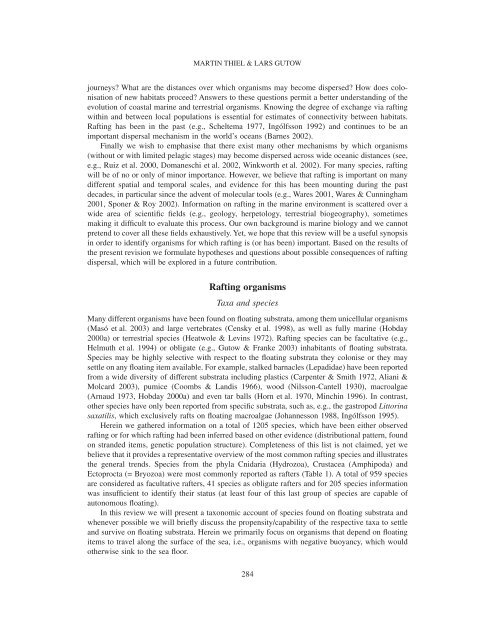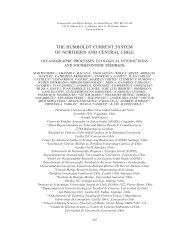The ecology of rafting in the marine environment - Bedim
The ecology of rafting in the marine environment - Bedim
The ecology of rafting in the marine environment - Bedim
You also want an ePaper? Increase the reach of your titles
YUMPU automatically turns print PDFs into web optimized ePapers that Google loves.
MARTIN THIEL & LARS GUTOW<br />
journeys? What are <strong>the</strong> distances over which organisms may become dispersed? How does colonisation<br />
<strong>of</strong> new habitats proceed? Answers to <strong>the</strong>se questions permit a better understand<strong>in</strong>g <strong>of</strong> <strong>the</strong><br />
evolution <strong>of</strong> coastal mar<strong>in</strong>e and terrestrial organisms. Know<strong>in</strong>g <strong>the</strong> degree <strong>of</strong> exchange via <strong>raft<strong>in</strong>g</strong><br />
with<strong>in</strong> and between local populations is essential for estimates <strong>of</strong> connectivity between habitats.<br />
Raft<strong>in</strong>g has been <strong>in</strong> <strong>the</strong> past (e.g., Scheltema 1977, Ingólfsson 1992) and cont<strong>in</strong>ues to be an<br />
important dispersal mechanism <strong>in</strong> <strong>the</strong> world’s oceans (Barnes 2002).<br />
F<strong>in</strong>ally we wish to emphasise that <strong>the</strong>re exist many o<strong>the</strong>r mechanisms by which organisms<br />
(without or with limited pelagic stages) may become dispersed across wide oceanic distances (see,<br />
e.g., Ruiz et al. 2000, Domaneschi et al. 2002, W<strong>in</strong>kworth et al. 2002). For many species, <strong>raft<strong>in</strong>g</strong><br />
will be <strong>of</strong> no or only <strong>of</strong> m<strong>in</strong>or importance. However, we believe that <strong>raft<strong>in</strong>g</strong> is important on many<br />
different spatial and temporal scales, and evidence for this has been mount<strong>in</strong>g dur<strong>in</strong>g <strong>the</strong> past<br />
decades, <strong>in</strong> particular s<strong>in</strong>ce <strong>the</strong> advent <strong>of</strong> molecular tools (e.g., Wares 2001, Wares & Cunn<strong>in</strong>gham<br />
2001, Sponer & Roy 2002). Information on <strong>raft<strong>in</strong>g</strong> <strong>in</strong> <strong>the</strong> mar<strong>in</strong>e <strong>environment</strong> is scattered over a<br />
wide area <strong>of</strong> scientific fields (e.g., geology, herpetology, terrestrial biogeography), sometimes<br />
mak<strong>in</strong>g it difficult to evaluate this process. Our own background is mar<strong>in</strong>e biology and we cannot<br />
pretend to cover all <strong>the</strong>se fields exhaustively. Yet, we hope that this review will be a useful synopsis<br />
<strong>in</strong> order to identify organisms for which <strong>raft<strong>in</strong>g</strong> is (or has been) important. Based on <strong>the</strong> results <strong>of</strong><br />
<strong>the</strong> present revision we formulate hypo<strong>the</strong>ses and questions about possible consequences <strong>of</strong> <strong>raft<strong>in</strong>g</strong><br />
dispersal, which will be explored <strong>in</strong> a future contribution.<br />
Raft<strong>in</strong>g organisms<br />
Taxa and species<br />
Many different organisms have been found on float<strong>in</strong>g substrata, among <strong>the</strong>m unicellular organisms<br />
(Masó et al. 2003) and large vertebrates (Censky et al. 1998), as well as fully mar<strong>in</strong>e (Hobday<br />
2000a) or terrestrial species (Heatwole & Lev<strong>in</strong>s 1972). Raft<strong>in</strong>g species can be facultative (e.g.,<br />
Helmuth et al. 1994) or obligate (e.g., Gutow & Franke 2003) <strong>in</strong>habitants <strong>of</strong> float<strong>in</strong>g substrata.<br />
Species may be highly selective with respect to <strong>the</strong> float<strong>in</strong>g substrata <strong>the</strong>y colonise or <strong>the</strong>y may<br />
settle on any float<strong>in</strong>g item available. For example, stalked barnacles (Lepadidae) have been reported<br />
from a wide diversity <strong>of</strong> different substrata <strong>in</strong>clud<strong>in</strong>g plastics (Carpenter & Smith 1972, Aliani &<br />
Molcard 2003), pumice (Coombs & Landis 1966), wood (Nilsson-Cantell 1930), macroalgae<br />
(Arnaud 1973, Hobday 2000a) and even tar balls (Horn et al. 1970, M<strong>in</strong>ch<strong>in</strong> 1996). In contrast,<br />
o<strong>the</strong>r species have only been reported from specific substrata, such as, e.g., <strong>the</strong> gastropod Littor<strong>in</strong>a<br />
saxatilis,<br />
which exclusively rafts on float<strong>in</strong>g macroalgae (Johannesson 1988, Ingólfsson 1995).<br />
Here<strong>in</strong> we ga<strong>the</strong>red <strong>in</strong>formation on a total <strong>of</strong> 1205 species, which have been ei<strong>the</strong>r observed<br />
<strong>raft<strong>in</strong>g</strong> or for which <strong>raft<strong>in</strong>g</strong> had been <strong>in</strong>ferred based on o<strong>the</strong>r evidence (distributional pattern, found<br />
on stranded items, genetic population structure). Completeness <strong>of</strong> this list is not claimed, yet we<br />
believe that it provides a representative overview <strong>of</strong> <strong>the</strong> most common <strong>raft<strong>in</strong>g</strong> species and illustrates<br />
<strong>the</strong> general trends. Species from <strong>the</strong> phyla Cnidaria (Hydrozoa), Crustacea (Amphipoda) and<br />
Ectoprocta (= Bryozoa) were most commonly reported as rafters (Table 1). A total <strong>of</strong> 959 species<br />
are considered as facultative rafters, 41 species as obligate rafters and for 205 species <strong>in</strong>formation<br />
was <strong>in</strong>sufficient to identify <strong>the</strong>ir status (at least four <strong>of</strong> this last group <strong>of</strong> species are capable <strong>of</strong><br />
autonomous float<strong>in</strong>g).<br />
In this review we will present a taxonomic account <strong>of</strong> species found on float<strong>in</strong>g substrata and<br />
whenever possible we will briefly discuss <strong>the</strong> propensity/capability <strong>of</strong> <strong>the</strong> respective taxa to settle<br />
and survive on float<strong>in</strong>g substrata. Here<strong>in</strong> we primarily focus on organisms that depend on float<strong>in</strong>g<br />
items to travel along <strong>the</strong> surface <strong>of</strong> <strong>the</strong> sea, i.e., organisms with negative buoyancy, which would<br />
o<strong>the</strong>rwise s<strong>in</strong>k to <strong>the</strong> sea floor.<br />
284










